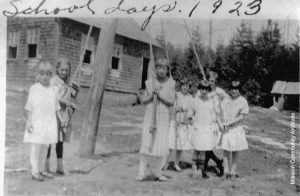Silverhill was growing in the early 1900s; by 1912, there were twelve children of school age living in Silverhill. The closest school was in Silverdale, and a long three and a half-mile walk each way, something parents did not want their kids completing. The province of BC was reluctant to build a school for such a small community, saying they would pay the teacher’s salary but not give funds to build the building itself. This may deter some communities from making a school, but not Silverhill. Instead, Mr. Wolfe donated land for the school to operate on; it was open for the school year 1916. The children in the first few years of schooling were almost solely Swedish. Interestingly, when a school board member visiting the school asked if they had any white children in her classroom or only Swedes? This is an interesting comment as it would appear that people from Sweden would fall under the “white” umbrella but this was not the case. It appears that Swedes were their own separate race within Canada. They were treated much better than other ethnicities attempting to make a living (see Japanese or Chinese relations) but were still not fully considered white and European.

The Boys of Silverhill School 1923
Despite the language barrier, learning was completed, and the teachers were respected in the community. The first Silverhill school was open until 1926. By this point, Silverhill had grown, and a bigger school had been built to accommodate. It was around this time that we can see a variety of cultures intermingling and learning as one. The Marshes and Mckormicks paddled across the river to attend Silverhill Elementary. The Marshes and McKormicks were most likely from the United Kingdom but possible of Irish descent, we also see the Donnatellis, an Italian family, attending school in Silverhill. Having all these different ethnicities within a classroom’s walls is not entirely foreign, especially for Canada. What was international and unique about this was the Maypole dance that many children learned. Thyra Shugge would teach Maypole dances to the children attending the Silverhill school. The Maypole dance is a Swedish dance that has been around for centuries to celebrate the Midsummer festival. This is something that most schools would not teach; however, it shows the unique setting that was Silverhill. These cross-cultural relations are, in part, what made Silverhill so unique.

Children Learning the Maypole Dance 1923